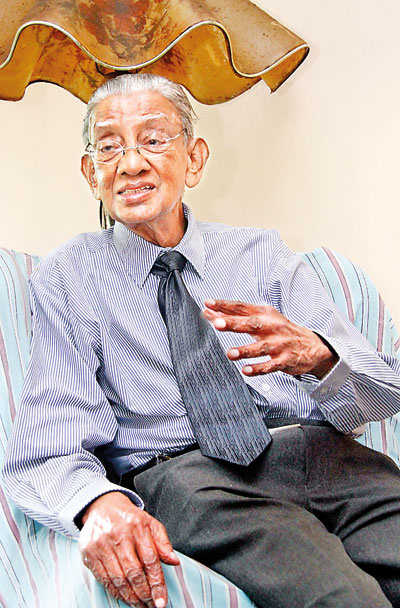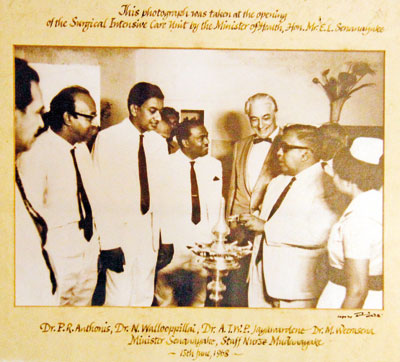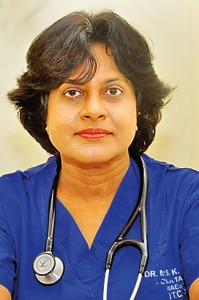News
50 years ago Sri Lanka got its first ICU
A rare black-and-white photograph says it all – the humble beginnings, the striving for excellence and the paving of the way to achieve greater things. All for the benefit of the patients who seek succour at state hospitals.

Dr. Thistle Jayawardene. Pix by Indika Handuwala & Priyantha Wickramarachchi
There is a quiet purposefulness and also excitement as deep within the National Hospital of Sri Lanka (NHSL) arrangements are underway for a celebration on Friday (June 15) – at the very ‘heart’ of the event will be a grand ward round.
The grand ward round at the Cardio-thoracic Intensive Care Unit (CICU) of the NHSL will be conducted by Consultant Anaesthetist Dr. Thistle Jayawardene as he is led by a throng of doctors and nurses headed by Senior-most Consultant Cardio-thoracic Anaesthetist and Intensivist now, Dr. Kumudini Ranatunga.
For, tall and lanky Dr. Jayawardene with the ‘oh so long name’ is the trailblazer in intensive care in Sri Lanka and gentle guru and beloved Sir to numerous doctors including Dr. Ranatunga.
June 15 is the golden-letter day on which the very first ICU in the country was opened back in 1968, at the Colombo General Hospital (now the NHSL), going from strength to strength, in this 50-year journey.
A big photograph of the opening of the Surgical ICU 50 years ago by then Health Minister E.L. Senanayake by lighting the traditional oil lamp surrounded by health-sector giants of those times adorns the walls of both the NHSL’s Cardio-thoracic ICU and the home of Dr. Jayawardene in Dehiwela. Those in the celebratory unit-opening photo include Dr. P.R. Anthonis, Dr. N. Wallooppillai, Dr. A. Thistle W.P. Jayawardene, Dr. M. Weerasena and Staff Nurse Mudanayake.
The picture worth a thousand words, meanwhile, portrays the early days where a nurse demonstrates the use of the de-fibrillator (a device that gives a high energy electric shock to the heart through the chest wall to someone who is in cardiac arrest).
The Sunday Times, treads back in time to those days of the 1960s just before the opening up of this life-giving and vital part of medicine, at the home of Dr. Jayawardene.
Young Dr. Jayawardene, armed with a Fellowship from the Royal College of Anaesthetists after training in England, had just returned to Sri Lanka when there was a massive transfer of Consultants and he was “thrown” to Badulla, where he worked for 1½ years in a general surgical setting in 1964. However, he had applied to be the Consultant Cardiothoracic Anaesthetist at Colombo and after a short stint in Kurunegala too, he found himself here.

The Colombo General Hospital’s Surgical ICU opening 50 years ago: Then Health Minister E.L. Senanayake does the honours by lighting the traditional oil lamp surrounded by (from left) Dr. P.R. Anthonis, Dr. N. Wallooppillai, Dr. A. Thistle W.P. Jayawardene and Dr. M. Weerasena and Staff Nurse Mudanayake (far right).
The Colombo General Hospital was bent on initiating open-heart surgery and in 1965 the State Department facilitated a “round trip” to America for five doctors and a nurse. They were Dr. Jayawardene himself who had the highest qualification in anaesthesia; Thoracic Surgeons Dr. A.T.S. Paul and Dr. T.D.S. Perera; Assistant Surgeon, Dr. Wilfred Perera; Anaesthetist Dr. K.C. Fernando who would man the heart-lung machine along with Nurse Jo.
In Washington, Houston and at the Mayo Clinic, the team saw it all, working alongside top heart surgeons and anaesthetists. The experience was marvellous because at a military hospital, Dr. Jayawardene sat-in on intense discussions over why some patients had died. He recalls an incident where a young anaesthetist had stressed how no person with less than 5g of haemoglobin could be anaesthetized and how the group was astonished to hear from Dr. Jayawardene that he had anaesthetized 500 patients with less than 5g of haemoglobin.
On the team’s return home they had met the Director of Health Services, Dr. Gunasekera, and Dr. Jayawardene had told him in no uncertain terms that no open-heart surgery could be done without intensive care facilities, even though there was a heart-lung machine (a machine that temporarily takes over the functions of the heart and lungs, especially during heart surgery).
“He (the Director) was extremely nice,” reminisces Dr. Jayawardene and entrusted the whole operation of setting up an ICU, giving him a “blank cheque” to plan, design, implement and manage the unit.
Those were the days when the Colombo General Hospital, the De Soysa Maternity Home, the Castle Street Hospital for Women and the Lady Ridgeway Hospital (LRH) for Children worked in tandem under one administration.
The Chief Anaesthetist, Dr. Umagiliya, who was Dr. Jayawardene’s boss had set up a recovery area at the central quadrangle of the Operating Theatre (OT) Complex and this was the “big room” that Dr. Jayawardene converted into the very first ICU of the country.
Having to equip it, he spoke to the Ceylon Oxygen people for the provision of wall oxygen, he says, smilingly adding that there was only one firm at that time.
The first ICU had facilities to monitor electrocardiograms, invasive blood pressure, central venous pressure and core and skin temperature. There were also three Bennet Pressure cycled ventilators and a Morgan Pulmonary Function Machine to assess the lung function of patients awaiting cardiac surgery. As this was the only pulmonary function machine in Sri Lanka at that time, even other patients, both from Colombo and the outstations, were referred to the unit to have pulmonary function tests.
The Radiometer pH and blood gas machine in the unit was the first in the country.

During the early days of the first ICU in Sri Lanka, a nurse demonstrates the use of the de-fibrillator – a (a device that gives a high energy electric shock to the heart through the chest wall to someone who is in cardiac arrest).
Proper lighting in the proposed ICU was Dr. Jayawardene’s passion, as he insisted that there should be ordinary bulbs rather than fluorescent lights. Why?
“With fluorescent lighting you cannot distinguish whether a patient is having cyanosis (turning blue) as it distorts the colour,” he says.
The Chairman of the Hospital Committee, Dr. E.M. Wijerama had suggested that two of the six beds be reserved for medical patients. This resulted in the unit being open for the admission of both medical and general surgical patients in addition to coronary care and cardiac surgical patients. This arrangement continued until such time as other intensive care/coronary care facilities became available. The unit also admitted paediatric surgical patients as well as neonates who needed to be ventilated until intensive care facilities were established at the LRH.
The training of staff for the ICU was also an onerous task as “nobody had a clue” and Dr. Jayawardene had to do everything himself. He was assigned four House Officers, “extremely fine fellows”, and clever Nurse Dayananda who had to be taught the intricacies of ‘intensive care’.
Nurse Dayananda, he says, was sent to England to look at an ICU and make a list of the necessities. She was very strict about the procedures in the newly-set up ICU of the Colombo General Hospital.
Recalling those early days, he says that there were no attendants and the nurses handled difficult tasks including giving the patients the bedpan. However, there was an electric washer to clean those bedpans.
Even the OT equipment was Dr. Jayawardene’s “headache”, so much so that his only son, Chalaka, seeing his Dad taking on such tedious responsibility vowed that he would never follow in his footsteps. However, his other family members – wife Amara, eldest daughter Dharini and youngest daughter Lakmini — did not murmur any protests, he says as wisps of memory come floating by, while there is a tinge of sadness, as both Amara and Lakmini, are no more.
As our interview draws to a close and a heavy shower comes down, Dr. Jayawardene leads us to his office room where hangs his stethoscope on the walls lined with book-cupboards. Treasured are large glass bottles packed tight with slides of those pioneering days.
We laugh over his name – Albert Thistlewayte Wilhelm Perera Jayawardene – and how it took a long time to fill out the forms after just three of them among 30 passed the viva on anaesthesia in England. Interestingly, he is also the only Anaesthetist in Sri Lanka who is also a Fellow of the American College of Cardiology.
Pointing to a batik painting of himself on the wall, he says that it was a gift for “treating a little fellow” and getting him out of a serious illness.
For paving the way for hundreds to follow along this essential pathway, Dr. Jayawardene had been honoured by the College of Anaesthesiologists and Intensivists as its first Fellow.
| The journey of critical care | |
Fifty years on, Dr. Kumudini Ranatunga, the Senior Consultant Cardio-thoracic Anaesthesiologist & Intensivist in charge of the National Hospital’s Cardio-thoracic Intensive Care Unit (CICU) says that the milestone of establishing the first ICU in 1968 “dramatically” improved the outcome of critically-ill patient management in Sri Lanka.  Dr. Kumudini Ranatunga Pointing out that the first cardiac surgery was performed at the Colombo General Hospital in 1966, she stresses that the very first ICU was established just two years later to care for these cardiac surgical patients post-operatively. “We did not lag too far behind the developed world in critical care medicine, as it was only in 1953 that the first ICU was set up in Denmark by Dr. Bjorn Ibsen and much later in the United Kingdom and the United States of America. This was due to the visionary effort of Dr. Thistle Jayawardene,” she says. Earlier, with the establishment of the thoracic units at the General Hospital, an area in the thoracic ward had been designated as a ‘recovery area’ in 1952, with an ECG monitor for post-operative patients. In the early 1960s, an East Radcliffe ventilator had also been secured, while ‘iron lungs’ were available at the General Hospital and a number of outstation hospitals. Even though the first ICU catered to post-operative cardiac surgical patients, it was firstly named the ‘Surgical ICU’, subsequently getting a name-change to ‘Cardiac ICU’. By 2001, cardiac intensive care facilities at the National Hospital were expanded to accommodate more patients and currently there are two – the fully-equipped Cardio-thoracic ICUs along with a high dependency unit. The state-of-the-art facilities which include post-operative transoesophageal echocardiography and haemodynamic support with intra-aortic balloon pumps and renal support with Continuous Renal Replacement Therapy machines have tremendously improved patient survival, says Dr. Ranatunga, adding that the initial introduction of most of these advancements in patient care has been through the SICU/CICU of the NHSL.  Flanking Dr. Kumudini Ranatunga the staff of the state-of-the-art Cardio-thoracic ICUs of the NHSL |

